![]()
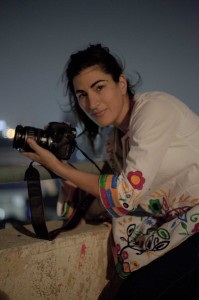
Filmed during the unfolding of the “Arab Spring” in 2011, when the Egyptian people demanded the resignation of dictator Hosni Mubarak, and continuing through the forced military removal of Muslim Brotherhood President Mohammed Morsi in summer of 2013, the film captures the determination and conflicting expectations of people united in revolution.
At the end of 2010 Noujaim was living in Egypt. She had grown up about 10 minutes from Tahrir Square. From 2005-2006 she made a film about three women fighting for political change, so she had already been following the protest movement for a long time and was attuned to political unrest that was brewing in the country.
“I have a big stake in what’s happening in Egypt and cared deeply about what was going on,” said Noujaim. “At the end of 2010, when the rumblings were happening that there was going to be a big protest in January on ‘Police Day,’ I called all of the people in my last film and friends of mine who are normally part of these movements and asked ‘Do you think this time it’s really going to break?’ We filmed so many movements and marches that had ended up with the majority of people being jailed, cameras smashed, and nobody comes back the next day.”
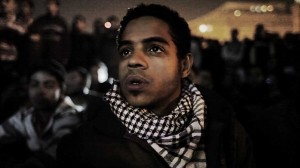
The director had shot her own films in the past. Although her film equipment was confiscated upon arrival, her Canon DSLR had been spared because the airport authorities were unaware of the camera’s video-capacity. “It was a happy accident because these cameras are actually so much more beautiful. The footage looks so filmic,” shared Noujaim.
The central point of the conflict, Tahrir Square, was not far from where Noujaim had her office. Drawn to character-driven films, when she joined the masses in the square, she discovered the diverse group of activists that would become the core of her story. Noujaim revealed, “The only way I know how to navigate a very complicated political situation is by following characters who I fall in love with, who inspire, who make me laugh, who I know are going to take me into worlds that I would not ordinarily get to see.”
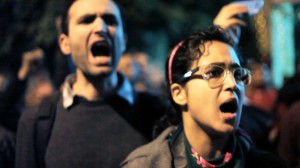 A number of stages were set up in the square to be used as platforms for people to express their opinions. Noujaim filmed Karim Amer setting up a stage for people who had no political affiliation. “Many were coming to that stage from miles away, just to read a poem,” she shared. The director started following Amer because she thought he would be an interesting character, but after about a week he told her, “I don’t want to be a character in the film, but I think you desperately need a producer. So I’ll be the producer.” He came on as the producer. (Recently, they got engaged.)
A number of stages were set up in the square to be used as platforms for people to express their opinions. Noujaim filmed Karim Amer setting up a stage for people who had no political affiliation. “Many were coming to that stage from miles away, just to read a poem,” she shared. The director started following Amer because she thought he would be an interesting character, but after about a week he told her, “I don’t want to be a character in the film, but I think you desperately need a producer. So I’ll be the producer.” He came on as the producer. (Recently, they got engaged.)
Noujaim met Cressida Trew, who became a shooter and an associate producer on the film, when the director asked her what she thought was happening. Trew suggested she talk to her boyfriend, now her husband. The most politically savvy of the film’s core characters, Khalid Abdalla was an actor who had been a lead character in The Kite Runner. From a well-off and political family that had been fighting for change over multiple generations, Abdalla was very articulate in describing the situation. “He was finishing his father’s work, in a way,” revealed Amer.
“The entire crew of people met each other in the square,” shared Noujaim. That’s where she met cinematographer Mohammed Hamdy. The most experienced cameraman on the crew, Hamdy, in addition to filming, trained the other shooters on the Canon DSLRs. The 60D, 5D and 7D were the primary cameras being used on the shoot. Although the characters had been given flip cameras to self-document, ultimately none of that footage was used because of stylistic differences with the footage from the professional cameras. All the footage in the film was shot by the filmmakers on the Canon cameras, other than the footage of the tanks running over protesters and the testimony footage after the singer had been beaten.
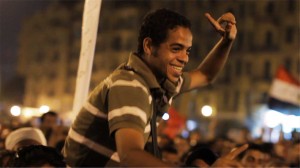 Ahmed Hassan, the young man who embodies the passionate idealism and hope of the revolution’s youth, not only became one of three key characters of the film, he also discovered a talent for shooting, graduating from a flip camera up to one of the Canon DSLRs about half-way through the film. He ended up supplying about 25% of the footage, in some of the most dangerous situations that the others did not dare to put themselves into. Although the actual shot of tanks running over un-armed civilians came from a cell phone video, Hassan volunteered to go into the square amid the chaos, to capture a vivid portrait of the unyielding courage of the protestors in the face of state aggression and death.
Ahmed Hassan, the young man who embodies the passionate idealism and hope of the revolution’s youth, not only became one of three key characters of the film, he also discovered a talent for shooting, graduating from a flip camera up to one of the Canon DSLRs about half-way through the film. He ended up supplying about 25% of the footage, in some of the most dangerous situations that the others did not dare to put themselves into. Although the actual shot of tanks running over un-armed civilians came from a cell phone video, Hassan volunteered to go into the square amid the chaos, to capture a vivid portrait of the unyielding courage of the protestors in the face of state aggression and death.
The third core character that Noujaim chose to follow was the devotedly religious Magdy Ashour. Conflicted between his allegiance to the Muslim brotherhood and his comrades from the square, he shared the common need for change. “What connects the three characters was that all three were unwilling to give up that sense of authorship for the future they felt was theirs,” shared Amer. “That’s why they keep going back to that square, because they keep trying to recreate that moment when everything was possible.”
After accumulating an enormous amount of footage, in September of 2011 the filmmakers began to shape the story in the cutting room. Egyptian editors, Mohammed el Manasterly and Angie Wegda, had the daunting task of going through the footage to whittle the edit down to about seven hours of material that they could then subtitle.
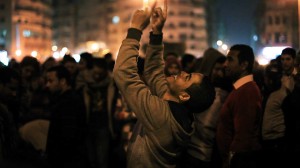 The production office was also a school of sorts, where many young people learned how to edit or record sound. A steady stream of young activists and filmmakers pitched in, adding their voices and opinions to the editing process. “Which made it a very democratic, but messy process.” Noujaim added, “Ultimately, it turned into a dictatorship, but much later on.”
The production office was also a school of sorts, where many young people learned how to edit or record sound. A steady stream of young activists and filmmakers pitched in, adding their voices and opinions to the editing process. “Which made it a very democratic, but messy process.” Noujaim added, “Ultimately, it turned into a dictatorship, but much later on.”
Feeling that it was important to get the film out as soon as possible, they worked quickly. Editors Christopher de la Torre, and Shareya Serag all came on to help for varying amounts of time. Noujaim divided the editing duties by assigning different months for each editor to work through, but as the filmmakers edited to meet the Sundance submission deadline, the story of the Egyptian protest movement was still developing. Renewed and violent protests erupted. Again they took to the streets, armed with their cameras. It also became clear to the director that they were not going to be able to submit the film to Sundance 2012.
October and November of 2011 were the most intense months of the uprising. During that period, Noujaim was arrested and held for a few days around Thanksgiving. For many, including Hassan, the horrible attacks brought the realization of the stark reality they were facing. At the height of the battle, he loses some of his hope and exclaims, “We’re only human after all.”
After Noujaim’s release, the crew was nervous. There had been a lot of raids in the areas, so they moved the edit room out of the production office to the beach and away from the intensity of the fight down the street in the square. They had to concentrate on the footage they had. Noujaim shared, “We had to wrap our heads around the story.” With the fluid nature of the events that they were covering, the filmmakers also had to free themselves of the traditional story construct of beginning, middle and end structure. Amer commented, “For us, it became a story about how change happens.”
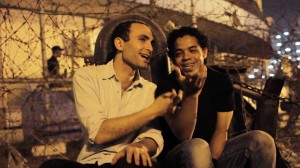 At the Red Sea edit room, about ten people, including Amer, Hamdy, el Manasterly and Wegda, continued to concentrate on the story. With the production operating on fumes in terms of funding, editor Jeremiah Zagar came from the U.S. and joined the team for about six weeks. Not knowing any of what had been happening, he came in with an outsider’s fresh perspective, editing a reel with Hassan’s voice leading the viewer through the first 10 minutes of the story. That reel became the basis for the style of the film. He was supposed to return to the U.S. for an HBO project, but Noujaim explained, “I heard him on the phone one day saying, ‘This is what my parents were fighting for in the ’60s. This is the civil rights movement of our time. And I feel I have to stay here and help the revolution.’ He took the project on in a very personal way.”
At the Red Sea edit room, about ten people, including Amer, Hamdy, el Manasterly and Wegda, continued to concentrate on the story. With the production operating on fumes in terms of funding, editor Jeremiah Zagar came from the U.S. and joined the team for about six weeks. Not knowing any of what had been happening, he came in with an outsider’s fresh perspective, editing a reel with Hassan’s voice leading the viewer through the first 10 minutes of the story. That reel became the basis for the style of the film. He was supposed to return to the U.S. for an HBO project, but Noujaim explained, “I heard him on the phone one day saying, ‘This is what my parents were fighting for in the ’60s. This is the civil rights movement of our time. And I feel I have to stay here and help the revolution.’ He took the project on in a very personal way.”
Although the filmmakers had not submitted their film for the festival, they attended Sundance with the sellers. They had a number of meetings and screened the 10-minute reel. Talking about the film, they got a number of people excited about the project. Noujaim also met documentary editor, Pedro Kos in Park City and asked him to come back to Cairo. At this point, Zagar had started another project and Noujaim knew they needed to work with another experienced editor. Although Kos loved the project, he had already committed to editing The Crash Reel for director Lucy Walker.
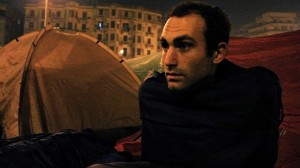 Back in Cairo, during February 2012, the team continued shooting. They had been looking for an editor to work with them, but the tumultuous times made it difficult to get anyone to come to Cairo. Noujaim attempted to get French editor Pierre Haberer onto the project, but he was editing another project.
Back in Cairo, during February 2012, the team continued shooting. They had been looking for an editor to work with them, but the tumultuous times made it difficult to get anyone to come to Cairo. Noujaim attempted to get French editor Pierre Haberer onto the project, but he was editing another project.
Executive producer, Mike Lerner suggested veteran British editor, Stefan Ronowicz, who had just completed the Sundance-winning documentary about Cambodia, Enemies of the People. He had the experience that Noujaim believed the film needed. When he agreed to help out, the edit room was moved to Acton in the U.K. “Having that experience and wisdom, there’s a generosity there that I felt our team needed,” stated Noujaim. “At that point it was Mohammed and Chris and Yasmin Kamal, one of the associate producers.”
Noujaim began working towards the 2013 Sundance deadline. Haberer was able to come on for a month to help them finish up. Working scene by scene, he applied his experience as a fiction film editor to add a narrative quality to the film. “We were working to really build a structure to the film,” said Noujaim. Narrowing the focus down from eight characters to three, they constructed a storyline from “bringing down a dictator to the election of a president.” The team used the verite´ conversations of the characters to tell the story as it was happening.
“The conversations that you are bringing people into are deeply personal and in the moment. The people having these conversations don’t have the need to explain backstory. All members of the conversation are active participants, so for an audience who is not up to speed on the day-to-day political continuum, it becomes very challenging,” revealed Amer.
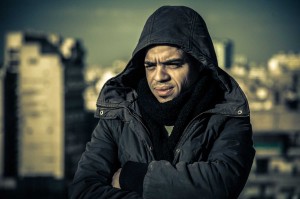 The story was too close to home. Noujaim explained, “We would watch it, then send it to friends of ours outside the country and they would say, ‘It looks really exciting, the footage is really intense. I feel like I’m right in the middle of it, but I just don’t understand what is happening. We were so inside it. You assume knowledge.”
The story was too close to home. Noujaim explained, “We would watch it, then send it to friends of ours outside the country and they would say, ‘It looks really exciting, the footage is really intense. I feel like I’m right in the middle of it, but I just don’t understand what is happening. We were so inside it. You assume knowledge.”
The filmmakers realized that when the narrative gets inundated with dates and historical data, there is only so much the audience can absorb. “When we made it more emotion-driven, we realized that was the only truth we could share,” added Amer. The filmmakers focused on the emotional truths that the main characters were feeling in the integral moments of the unfolding revolution and reshaped the edit to make it more emotion-driven, allowing the audience to connect to the emotional truth and understand the situation from the perspective of the characters.
Noujaim submitted the film to Sundance and it was accepted. This was in November 2012 when once more the core characters took to the streets to protest the dictatorial power-grab by Muslim Brotherhood President Morsi. It was apparent that the story was still on going. The filmmakers faced a difficult decision.
“The film had a beautiful structure. It flowed. It was 87 minutes… the perfect amount of time. It was a big decision to go back, but we felt like we would not be making an authentic story,” revealed Noujaim. “We thought the story was much more interesting and complex because it became about what these characters were actually after, which was not just about a struggle against the military and Mubarek, but about changing the system and holding your government accountable.”
Stefan blessed the project, but Pierre went to Egypt with the team. They continued filming through mid-2013, opening up the structure by adding graffiti work as chapter breaks. The edit that premiered at Sundance 2013 was presented as a work in progress without credits, color-correct or sound mix. “It was one of the best decisions we made,” said Noujaim. “We won the audience award.” For the team of thirty people who had been living with the film for two years, it was an affirmation that they had touched the hearts of the people half-way around the world.
At Sundance, they reconnected with Kos where The Crash Reel was also showing. The timing was right and he agreed to take the film forward and finish the final editing phase, extending the story to include the bringing down of Morsi. After a couple of months more in Egypt, the film moved to Los Angeles. De la Torre, who had been with the film since early on and knew the footage intimately, continued on the project.
Noujaim was back in Egypt during June and July of 2013 to complete the final filming. Finally the story had come to an end, as the characters realized that no one was going to come and solve their problems. It really was a case of a changing consciousness, which was tangibly a new constitution for the people. Noujaim returned to Los Angeles, completed the edit and finished the film with Skywalker doing the sound and Dalia Alia, an Egyptian who had been in the square who was now at film school at UCLA, jumping in to color-time the picture a few days before its Toronto opening.
Despite all the difficulties, Noujaim and Amer feel the film was blessed. “At the right moment, the right person would show up and push forth with a new energy. It was amazing teamwork,” said Amer.
Noujaim added, “It was reflective of the revolution, a kind of passing of the baton. Each felt they were working on something that was bigger than themselves.”





